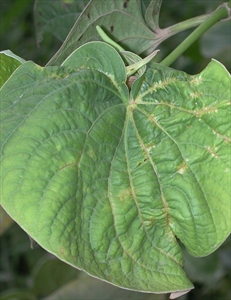- Worldwide distribution. A virus with a large host range. It is especially common in the cucumber, legume and potato families. Common on kava, banana, cantaloupe melon, capsicum, chilli, pumpkin, snake gourd, tomato and watermelon, and in weeds.
- Spread is by aphids.
- On kava, look for crinkled leaves, with patches of yellow or white along the veins; cut stems to find brown lines inside, and black rotten stems that break.
- Cultural control: plant away from other kava in well-drained fertile soil under shade; surround plots with e.g., bananas, bele, cassava, citrus, papaya, sugarcane; plant cuttings in nursery to check if free from disease; weed; if disease occurs break off diseased stem just above ground level. If the plant is less than 1-year-old, replace the plant.
- Chemical control: none recommended.






